Symphonic metal composition combines orchestral elements with heavy metal, creating a rich and immersive sound. This article explores orchestration techniques, major groups like Nightwish and Epica, and evolving lyrical themes. It also examines emerging trends in the genre and offers insights for composers on integrating orchestral and metal components effectively.
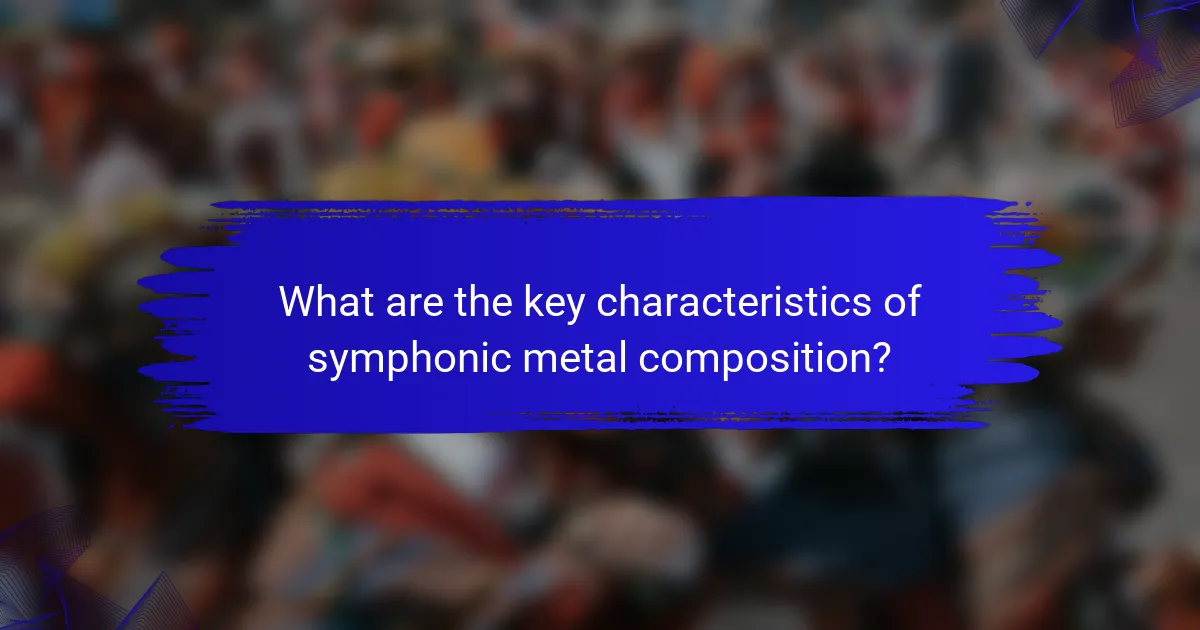
What are the key characteristics of symphonic metal composition?
Symphonic metal composition features orchestral elements combined with heavy metal. Key characteristics include complex arrangements, use of classical instruments, and dynamic contrasts.
Orchestration often involves strings, brass, and woodwinds alongside electric guitars and drums. Major groups in this genre include Nightwish, Epica, and Within Temptation, known for their theatrical and emotive sound.
The genre blends operatic vocals with powerful instrumentals, creating an immersive listening experience. Unique attributes may include narrative-driven lyrics and elaborate stage performances.
How do orchestral elements enhance symphonic metal music?
Orchestral elements significantly enhance symphonic metal music by adding depth and richness. They create a cinematic atmosphere, elevating emotional intensity and complexity. Strings, brass, and woodwinds contribute unique textures, while orchestral arrangements support dynamic contrasts. This fusion allows symphonic metal to explore diverse themes and expand musical narratives.
Which instruments are commonly used in symphonic metal bands?
Symphonic metal bands commonly use orchestral instruments alongside traditional rock elements. Key instruments include strings, brass, woodwinds, and percussion, complemented by electric guitars, bass, and drums. Strings, such as violins and cellos, add depth, while brass instruments like trumpets enhance the grandeur. Woodwinds, including flutes and clarinets, contribute melodic layers. Percussion enriches the rhythmic foundation, creating a powerful sound. This combination of instruments defines the genre’s unique orchestration.
What role does melody play in symphonic metal compositions?
Melody plays a crucial role in symphonic metal compositions by providing emotional depth and enhancing the overall atmosphere. It serves as a vehicle for storytelling, allowing for dynamic contrasts between orchestral sections and heavy instrumentation. Melodic lines often intertwine with symphonic elements, creating a rich tapestry of sound that defines the genre. The integration of classical melodies with metal riffs helps to establish a unique identity and engages listeners on multiple levels.
How does rhythm contribute to the overall sound of symphonic metal?
Rhythm is crucial in symphonic metal as it shapes the genre’s dynamic energy and emotional intensity. It combines traditional metal’s aggressive beats with orchestral elements, creating a rich soundscape. The interplay between heavy guitar riffs and orchestral rhythms enhances the overall composition, allowing for dramatic contrasts. This rhythmic complexity fosters a unique listening experience, engaging audiences through varied tempos and time signatures.
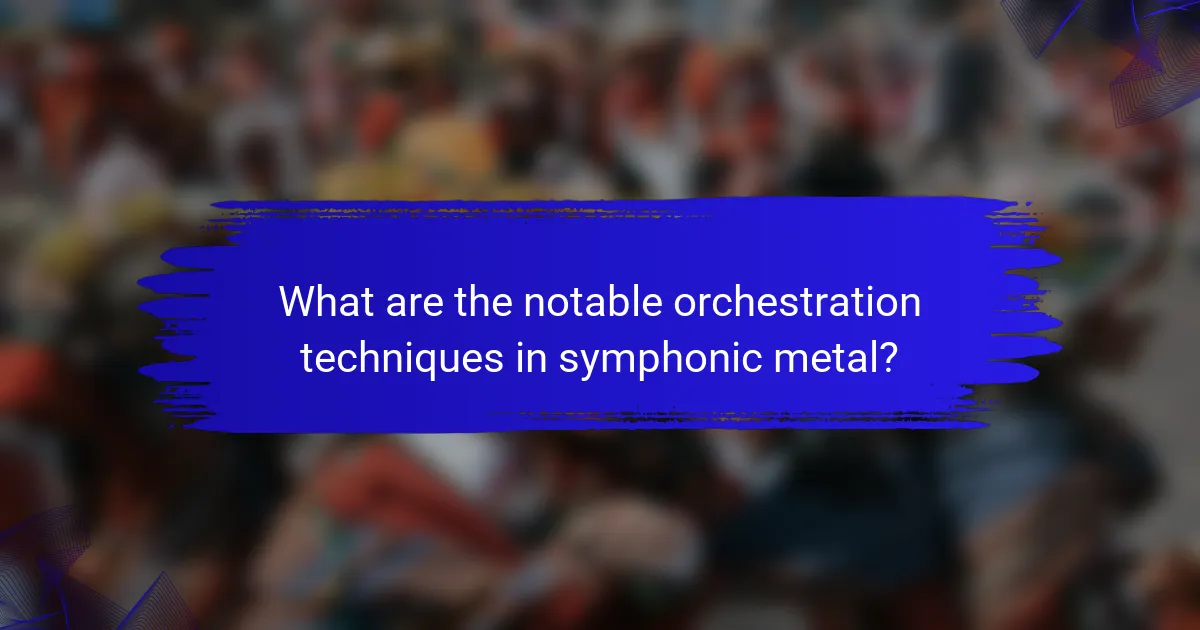
What are the notable orchestration techniques in symphonic metal?
Notable orchestration techniques in symphonic metal include blending orchestral instruments with traditional rock elements, utilizing complex arrangements, and integrating choirs for depth. These techniques enhance the genre’s theatricality and emotional impact. The use of strings, brass, and woodwinds alongside electric guitars creates a rich soundscape. Additionally, dynamic contrasts and thematic development are essential for maintaining listener engagement. Major groups like Nightwish and Epica exemplify these techniques in their compositions.
How is layering utilized in symphonic metal arrangements?
Layering in symphonic metal arrangements creates depth and complexity by combining orchestral instruments with traditional metal elements. This technique enhances the overall sound, allowing for rich textures and dynamic contrasts. For example, strings might underpin guitar riffs, while choirs add vocal harmonies that elevate the emotional impact. The unique attribute of layering in this genre is its ability to seamlessly integrate diverse musical influences, resulting in a powerful auditory experience.
What are the unique approaches to harmony in symphonic metal?
Symphonic metal employs unique approaches to harmony by blending orchestral elements with heavy metal. This genre often features complex chord progressions that enhance emotional depth.
Orchestration plays a critical role, utilizing strings, brass, and woodwinds alongside electric guitars and drums. This fusion creates layered textures that distinguish symphonic metal from traditional metal.
Major groups like Nightwish and Epica exemplify innovative harmonic structures, often incorporating classical techniques. Their compositions typically include operatic vocals and intricate arrangements that elevate the overall sound.
The use of modal interchange and unconventional scales further contributes to the genre’s distinctive harmonic landscape, allowing for a rich exploration of musical themes.
How do dynamics affect the emotional impact of symphonic metal pieces?
Dynamics significantly shape the emotional impact of symphonic metal pieces by creating contrasts and intensifying listener engagement. Variations in volume, tempo, and orchestration evoke a range of feelings, from euphoria to melancholy. For instance, crescendos can amplify excitement, while softer passages often induce introspection. The interplay of heavy guitar riffs with orchestral elements enhances emotional depth, making the experience more immersive. Overall, dynamics serve as a powerful tool in conveying complex emotions within the genre.
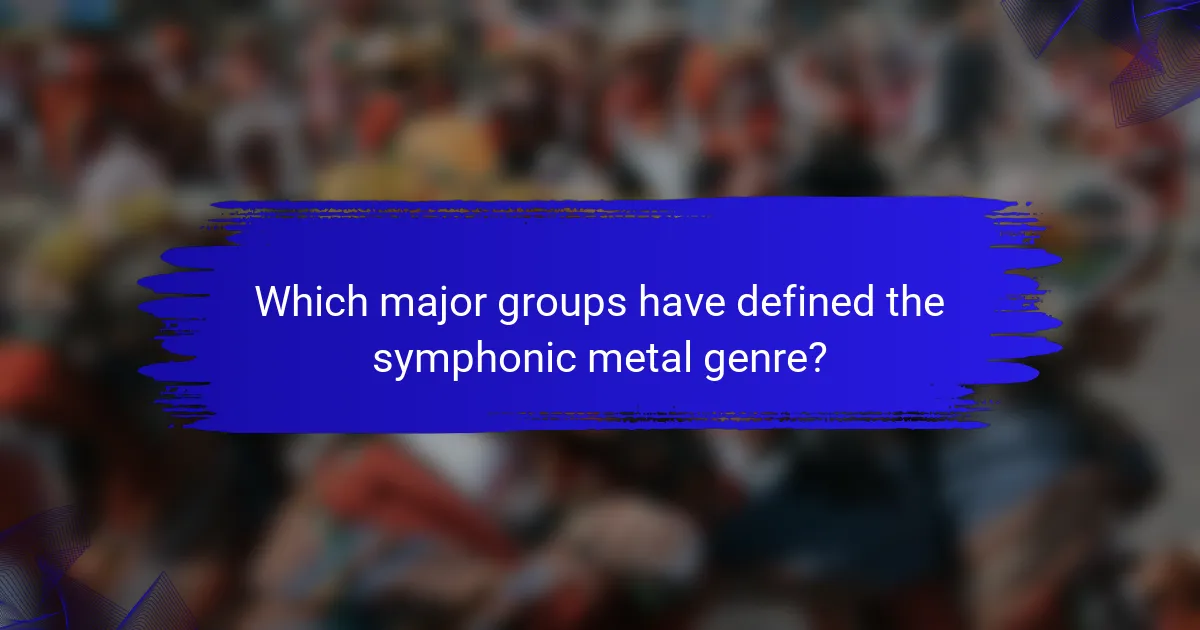
Which major groups have defined the symphonic metal genre?
The major groups that have defined the symphonic metal genre include Nightwish, Epica, and Within Temptation. Nightwish pioneered the genre with their blend of classical music and metal elements, characterized by orchestral arrangements and operatic vocals. Epica followed with a focus on symphonic elements and lyrical themes drawn from philosophy and literature. Within Temptation contributed to the genre’s popularity through their atmospheric sound and powerful performances. Other notable groups like Kamelot and Delain have also played significant roles in shaping symphonic metal’s identity.
What are the contributions of Nightwish to symphonic metal?
Nightwish significantly shaped symphonic metal through their innovative compositions and orchestration techniques. They blend classical elements with metal, creating a unique sound that features orchestral arrangements, operatic vocals, and rich harmonies. Their albums, such as “Once” and “Dark Passion Play,” showcase complex song structures and thematic depth, elevating the genre. Nightwish’s influence extends to inspiring numerous bands and expanding the symphonic metal audience globally. Their use of storytelling and emotional intensity further distinguishes them, making them a pivotal force in the evolution of symphonic metal.
How has Epica influenced the evolution of symphonic metal?
Epica has significantly shaped the evolution of symphonic metal through innovative composition and orchestration. Their integration of classical elements with heavy metal has redefined genre boundaries.
The band’s use of operatic vocals and orchestral arrangements has inspired numerous groups, enhancing the genre’s complexity. Epica’s lyrical themes often explore philosophical and existential topics, adding depth to their music.
Their pioneering album “The Phantom Agony” showcased a unique blend of symphonic elements and metal, influencing emerging bands. As a result, many groups now incorporate similar orchestral techniques and diverse instrumentation, further evolving the symphonic metal landscape.
Epica’s impact is evident in their collaborations with orchestras and choirs, setting a standard for live performances. This has encouraged other bands to adopt grander, more theatrical approaches, solidifying symphonic metal’s place in modern music.
What role does Within Temptation play in the global symphonic metal scene?
Within Temptation plays a pivotal role in the global symphonic metal scene by blending orchestral elements with heavy metal. Their innovative compositions and powerful vocals have influenced the genre’s evolution. The band is known for integrating lush arrangements and thematic storytelling in their music, setting a standard for symphonic metal groups. Their unique attribute lies in their ability to seamlessly combine atmospheric soundscapes with dynamic instrumentation, which has garnered them a dedicated international fanbase. As a result, Within Temptation has become a key player in popularizing symphonic metal across diverse audiences.
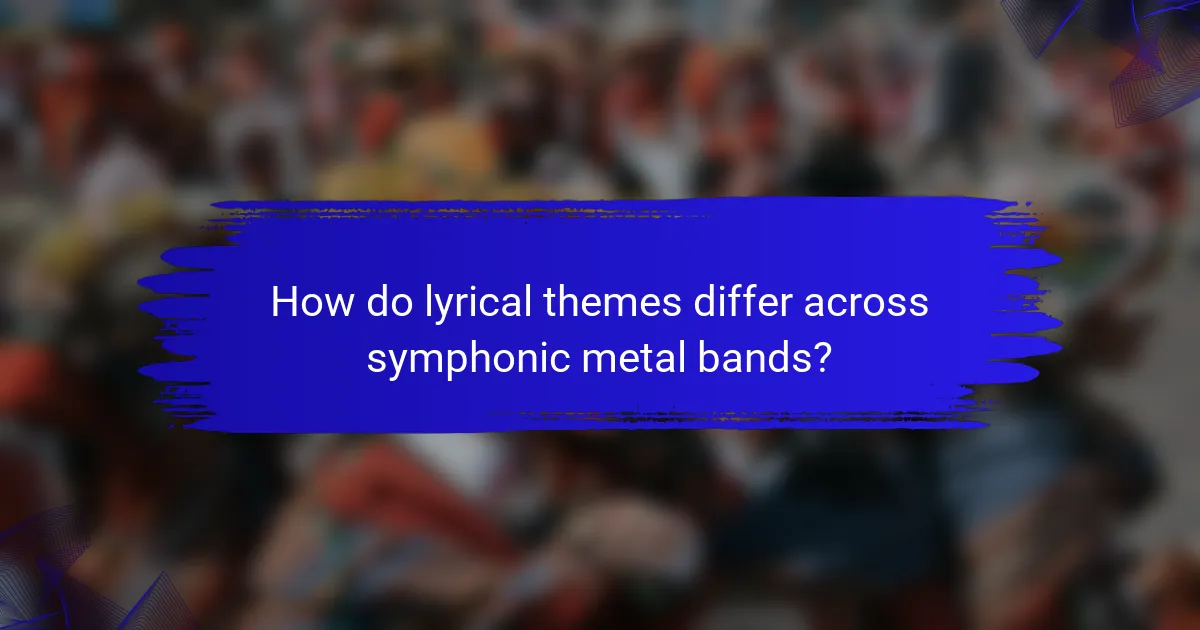
How do lyrical themes differ across symphonic metal bands?
Lyrical themes in symphonic metal bands often vary significantly, reflecting diverse influences and narratives. Many bands explore fantasy and mythology, while others delve into personal struggles or societal issues.
For instance, Nightwish frequently incorporates themes of nature and existentialism, contrasting with Epica’s focus on philosophical and political topics. Similarly, Within Temptation often emphasizes emotional storytelling, while Delain leans toward romantic and introspective lyrics.
These differences arise from unique attributes of each band, shaping their lyrical identity and connecting with distinct audiences. As a result, symphonic metal presents a rich tapestry of themes that resonate across varied listener experiences.
What are common storytelling elements in symphonic metal lyrics?
Symphonic metal lyrics often incorporate storytelling elements such as vivid imagery, character development, and thematic depth. These elements create a narrative that engages listeners emotionally and intellectually.
Common themes include fantasy, mythology, and personal struggles, often reflecting a journey or transformation. The use of dramatic contrasts, such as light and dark motifs, enhances the storytelling, creating tension and resolution.
Additionally, orchestration plays a crucial role, with symphonic arrangements complementing the lyrical narrative. This combination of music and lyrics fosters an immersive experience that draws the audience into the story.
Major groups in symphonic metal, like Nightwish and Epica, exemplify these storytelling techniques, using complex narratives to convey their artistic vision.
How do cultural influences shape lyrical content in symphonic metal?
Cultural influences significantly shape lyrical content in symphonic metal by integrating diverse themes and narratives. This genre often draws from mythology, literature, and historical events, reflecting the cultural backgrounds of its creators. For example, bands like Nightwish and Epica incorporate elements from European folklore and classical literature, enhancing their storytelling. Additionally, regional cultural motifs can introduce unique attributes, such as specific musical scales or lyrical styles, enriching the overall composition. As a result, symphonic metal becomes a canvas for cultural expression, allowing listeners to connect with varied traditions and histories.
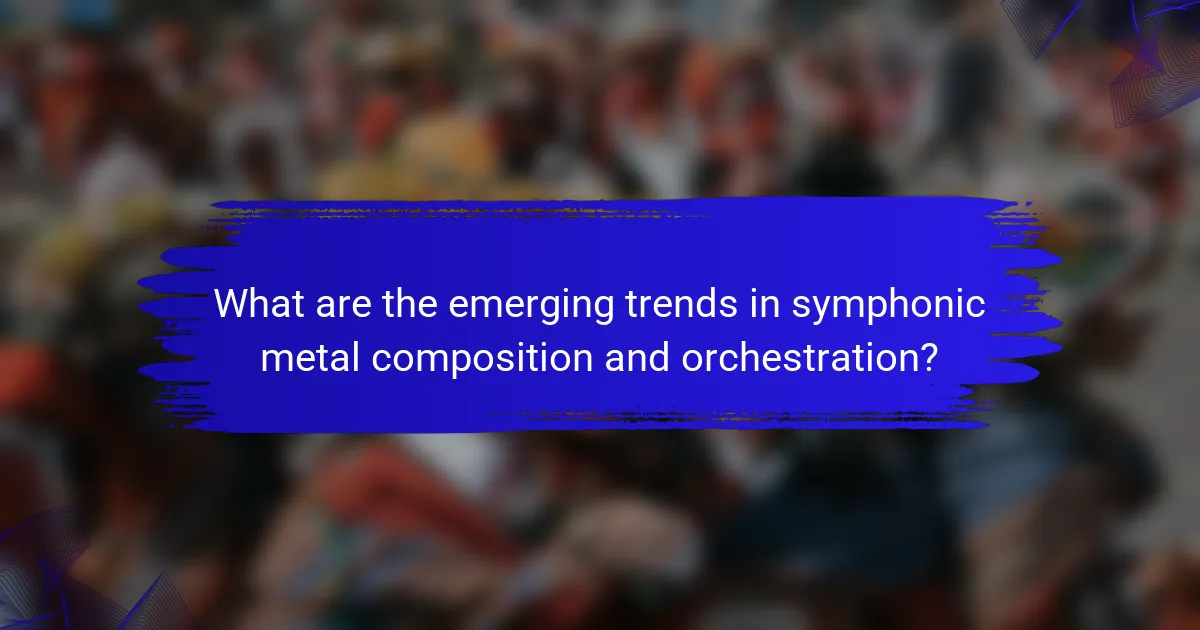
What are the emerging trends in symphonic metal composition and orchestration?
Emerging trends in symphonic metal composition and orchestration include the integration of diverse musical genres, utilization of advanced technology, and collaboration with classical musicians. These trends enhance the genre’s complexity and appeal.
The fusion of elements from genres like progressive rock and electronic music adds depth to compositions. Artists increasingly experiment with unconventional song structures and rhythms. Moreover, advancements in music production technology allow for richer soundscapes and intricate layering.
Collaborations with orchestras and classical musicians are becoming more common, bringing authentic orchestral sounds into symphonic metal. This practice elevates arrangements and creates a more immersive listening experience.
Additionally, lyrical themes are evolving to address contemporary issues, reflecting societal changes. This shift resonates with audiences, making the genre more relevant. Overall, these trends signify a dynamic evolution in symphonic metal, pushing creative boundaries.
How are modern technologies being integrated into symphonic metal production?
Modern technologies enhance symphonic metal production through advanced software, digital instruments, and innovative recording techniques. These tools allow for intricate compositions and orchestration, blending classical elements with heavy metal. Digital audio workstations enable seamless integration of orchestral samples, facilitating complex arrangements. Additionally, virtual instruments provide flexibility in sound design, allowing composers to experiment extensively. Major groups in the genre, such as Nightwish and Epica, utilize these technologies to create immersive soundscapes, showcasing the genre’s evolution.
Which new bands are pushing the boundaries of symphonic metal?
Several new bands are innovating within symphonic metal, expanding its boundaries. Notable groups include Spiritbox, known for their blend of heavy metal with ethereal vocals, and The Charm The Fury, which incorporates diverse genres into their orchestration. Another emerging band, Elysion, fuses gothic elements with symphonic arrangements, adding depth to their sound. Additionally, the band Temperance combines melodic metal with symphonic influences, showcasing dynamic compositions. These bands are redefining the genre by integrating various musical styles and modern production techniques.
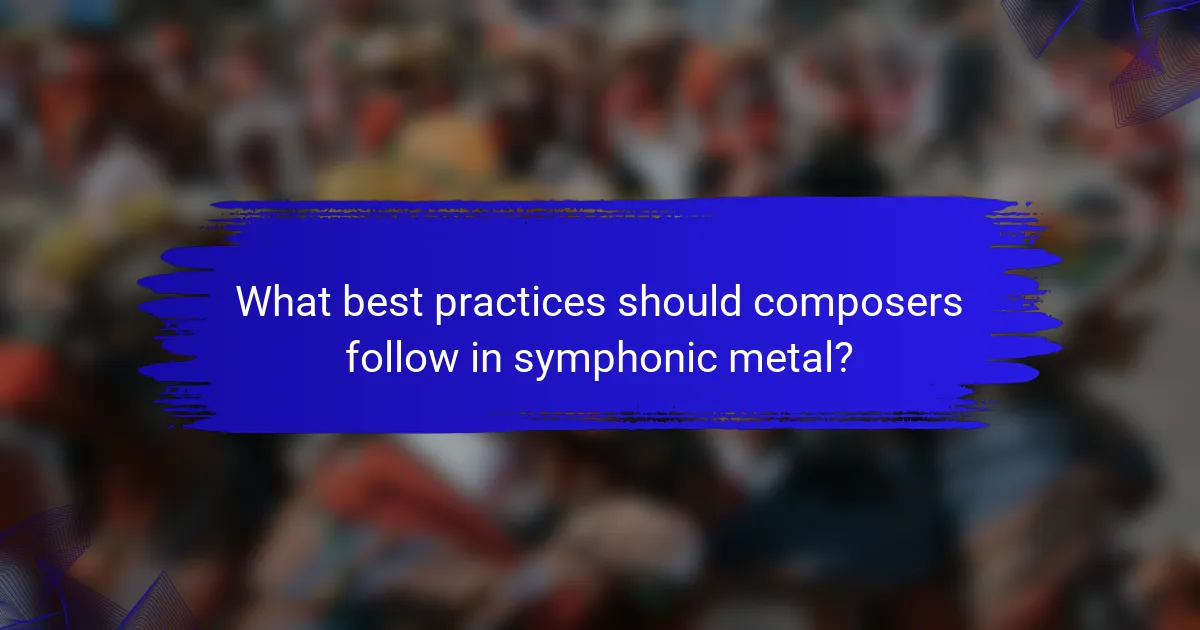
What best practices should composers follow in symphonic metal?
Composers in symphonic metal should integrate orchestral elements seamlessly with metal components. Focus on thematic development, dynamic contrasts, and layering textures to create depth.
Utilize a variety of instruments, including strings, brass, and woodwinds, to enhance the overall sound. Experiment with orchestration techniques to highlight both the symphonic and metal aspects.
Incorporate strong melodies and harmonies that resonate emotionally with the audience. Balance heavy guitar riffs with orchestral arrangements to maintain cohesion.
Pay attention to arrangement structure, allowing for both intricate passages and powerful climaxes. This approach ensures a captivating listening experience that showcases the genre’s unique blend of styles.
How can composers effectively blend orchestral and metal elements?
Composers can effectively blend orchestral and metal elements by integrating orchestral arrangements with metal instrumentation. This fusion creates a unique sound that enhances emotional depth and complexity.
Utilizing orchestral strings, brass, and woodwinds alongside electric guitars and drums allows for dynamic contrasts. Composers should pay attention to the arrangement, ensuring that orchestral sections complement metal riffs rather than overpower them.
Employing techniques such as counterpoint and thematic development can enrich the composition. A balanced mix of orchestral and metal elements can lead to powerful crescendos and intricate harmonies, appealing to diverse audiences.
Exploring different time signatures and tempos can also add variety, creating an engaging listening experience. Collaborating with skilled musicians from both genres can further enhance the final product, resulting in a cohesive and innovative symphonic metal piece.
What common mistakes should be avoided in symphonic metal composition?
Common mistakes to avoid in symphonic metal composition include neglecting orchestration balance, overcomplicating arrangements, and ignoring thematic coherence. Failing to integrate metal elements with orchestral components can lead to a disjointed sound. Additionally, repetitive motifs without variation can diminish listener engagement. Prioritizing technical prowess over emotional impact can also result in compositions that lack depth.
How can understanding audience preferences enhance symphonic metal creation?
Understanding audience preferences enhances symphonic metal creation by aligning compositions with listener desires. Tailoring orchestration and themes to audience tastes fosters deeper emotional connections. Engaging with fan feedback can reveal unique attributes, such as preferred instrumentation or lyrical themes, which can guide creative decisions. Additionally, analyzing demographic trends helps identify emerging influences, ensuring the music remains relevant and appealing.